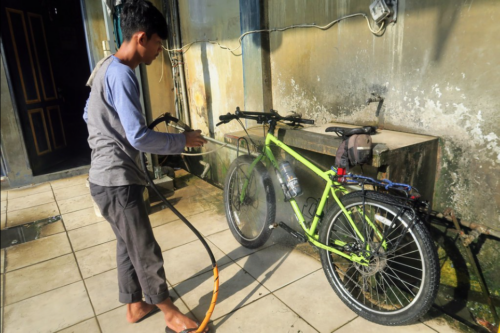Cycle Care
Cycle Care
Cycle maintenance refers to the regular tasks and procedures involved in ensuring that a bicycle is in good working order. Proper maintenance helps prevent breakdowns, extend the lifespan of components, and improve overall performance and safety. Whether you’re a casual rider or an avid cyclist, understanding basic bike maintenance is essential to getting the most out of your bike.
Here’s a comprehensive guide to cycle maintenance, covering common tasks you can do yourself to keep your bike running smoothly:
1. Cleaning Your Bike
Why it’s important: Dirt, mud, and grime can accumulate on your bike, causing premature wear and affecting performance.
- What to clean:
- Frame (using a mild detergent or bike cleaner).
- Drivetrain (chain, chainrings, cassette, and derailleurs).
- Wheels (rims or disc rotors).
- Brakes (pads and rotors, if applicable).
- How to clean:
- Use a soft brush or cloth to scrub off dirt.
- Apply a degreaser to the chain, cassette, and derailleurs, then scrub with a brush.
- Rinse gently with a hose or bucket of water (avoid high-pressure water jets to prevent damaging seals).
- Dry the bike with a clean towel to prevent rust.
2. Lubricating the Chain
Why it’s important: A well-lubed chain reduces friction, improves efficiency, and prolongs the life of your drivetrain components.
- When to lubricate:
- After cleaning your bike.
- If the chain looks dry or feels noisy.
- After riding in wet or muddy conditions.
- How to lubricate:
- Apply a drop of chain lube to each link while rotating the pedals backward.
- Wipe off excess lube to prevent dirt from sticking to the chain.
3. Checking Tire Pressure
Why it’s important: Properly inflated tires provide better grip, efficiency, and reduce the risk of flats.
- How to check:
- Use a bike pump with a pressure gauge to check the tire pressure.
- Recommended pressure is often listed on the side of the tire. Typically, road tires are inflated to 80-130 PSI, and mountain bike tires to 30-50 PSI.
- What to do if pressure is low:
- Inflate the tires to the recommended PSI using a floor pump or hand pump.
- If you ride in hot weather, be cautious of over-inflating, as tire pressure can increase in the sun.
4. Checking Brake Pads
Why it’s important: Ensuring your brake pads are in good condition is essential for your safety. Worn brake pads can reduce stopping power, especially in wet or rainy conditions.
- How to check:
- Inspect the pads for wear. If they are thin (around 1mm), it’s time to replace them.
- For rim brakes, ensure the pads are aligned with the rim and not touching the tire.
- For disc brakes, check for wear on the pads and rotors.
- What to do if pads are worn:
- Replace the brake pads with the correct type for your brake system (rim or disc brakes).
- Adjust the brake pads for proper alignment to ensure efficient braking.
5. Checking the Chain for Wear
Why it’s important: A worn-out chain can cause poor shifting performance and can wear down your cassette and chainrings, resulting in costly replacements.
- How to check:
- Use a chain checker tool to measure chain wear. A chain is considered worn if it has stretched beyond a certain percentage (usually 0.5% or 0.75%).
- If the chain is too worn, it’s best to replace it before it damages the cassette and chainrings.
6. Adjusting the Derailleurs
Why it’s important: Proper derailleur adjustments ensure smooth shifting, which improves efficiency and prevents chain drops.
- How to adjust:
- For rear derailleur: Use the barrel adjuster to fine-tune the shifting, ensuring that the derailleur moves smoothly between cogs.
- For front derailleur: Adjust the limit screws to ensure it shifts correctly onto the large and small chainrings.
7. Truing the Wheels
Why it’s important: Wheels can become out of true (not perfectly straight) due to impacts or general use, which can cause braking issues or a bumpy ride.
- How to check:
- Spin the wheels and observe if they wobble from side to side.
- A slight wobble can be fixed by adjusting spoke tension with a spoke wrench.
- If the wheel is severely out of true, you may need a professional bike shop to fix it.
8. Tightening Bolts and Screws
Why it’s important: Over time, bolts on your bike can loosen due to vibrations while riding, which can affect your bike’s safety and performance.
- How to check:
- Regularly inspect bolts on the handlebars, stem, seat post, pedals, and other components.
- Use an Allen wrench to tighten any loose bolts, but avoid over-tightening to prevent stripping.
9. Inspecting the Frame
Why it’s important: Cracks or damage to the frame can compromise your bike’s structural integrity.
- What to do:
- Inspect the frame for any visible cracks, dents, or other signs of damage.
- Check welds and areas of high stress, like around the bottom bracket and head tube.
- If you find any damage, consult a professional to determine if the frame needs to be replaced.
10. Suspension Maintenance (for MTB or Suspension Bikes)
Why it’s important: Suspension needs regular maintenance to ensure smooth travel and proper damping, especially if you ride on rough terrain.
- What to check:
- Inspect the fork and shock for any oil leaks or damage.
- Adjust air pressure based on your weight and riding style.
- Ensure the suspension is set up correctly for your riding conditions.
- Some suspension forks and shocks may need periodic servicing or a full rebuild, depending on the brand and model.
11. Replacing Cables and Housing
Why it’s important: Worn cables or damaged housing can cause poor shifting or braking performance.
- How to check:
- Inspect brake and shift cables for signs of wear, fraying, or rust.
- If the cables are sticking or difficult to operate, it’s time to replace them and their housing.
Cycle Maintenance Checklist
- Weekly (or after every ride):
- Clean your bike.
- Check tire pressure.
- Inspect the chain and lubricate if necessary.
- Check brakes and brake pads for wear.
- Monthly:
- Inspect and adjust the drivetrain (shifters, derailleurs).
- Check for chain wear.
- Check the wheel trueness and spoke tension.
- Inspect the frame for any cracks or damage.
- Every 3-6 Months:
- Perform a full drivetrain cleaning.
- Inspect and replace brake pads if necessary.
- Clean and re-lube suspension components (for mountain bikes).
- Check bottom bracket and headset for play.
Basic Bike Maintenance Tools:
- Bike pump with a pressure gauge
- Chain tool or chain checker
- Torque wrench (for precise bolt tightening)
- Allen wrenches (for adjusting components)
- Spoke wrench
- Pedal wrench
- Tire levers
- Patch kit for fixing flats
- Lubricants (for the chain and other moving parts)
- Degreaser (for cleaning the drivetrain)
- Brushes and cloths for cleaning
Conclusion:
Regular cycle maintenance not only improves performance and safety, but it also helps prevent major repairs down the road. By following a simple maintenance routine, you can ensure your bike is always ready for the next ride. Even if you’re not mechanically inclined, many of these tasks are simple and can be done with minimal tools. However, for complex repairs (like wheel truing, suspension servicing, or hydraulic brake bleeding), it’s always a good idea to consult a professional bike mechanic.
Happy cycling!






